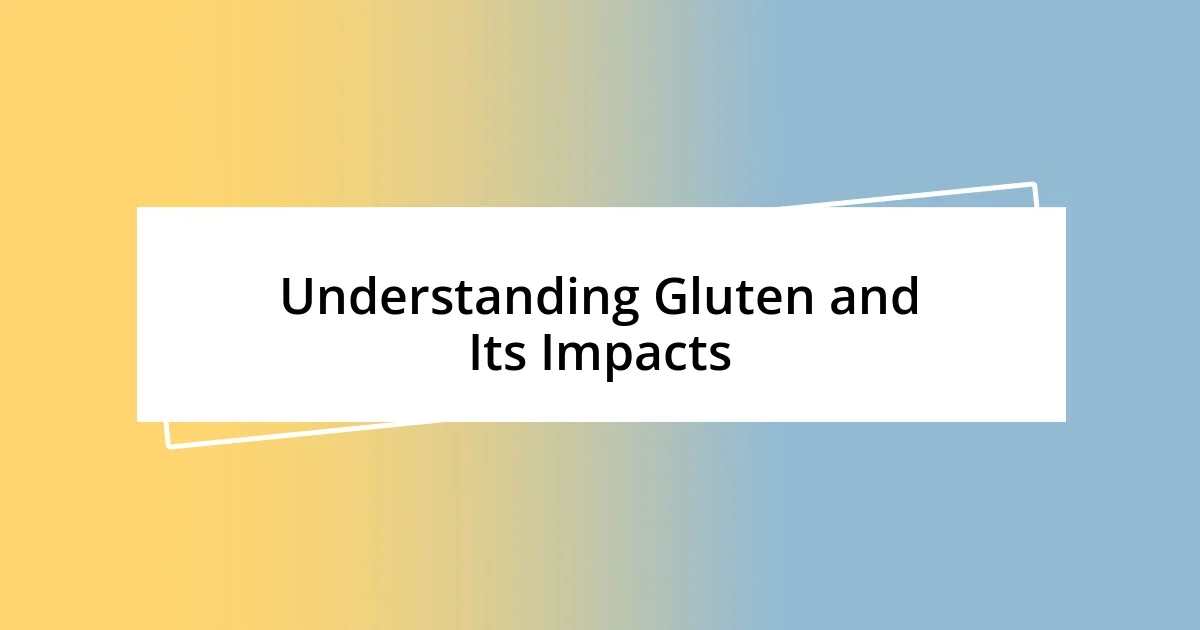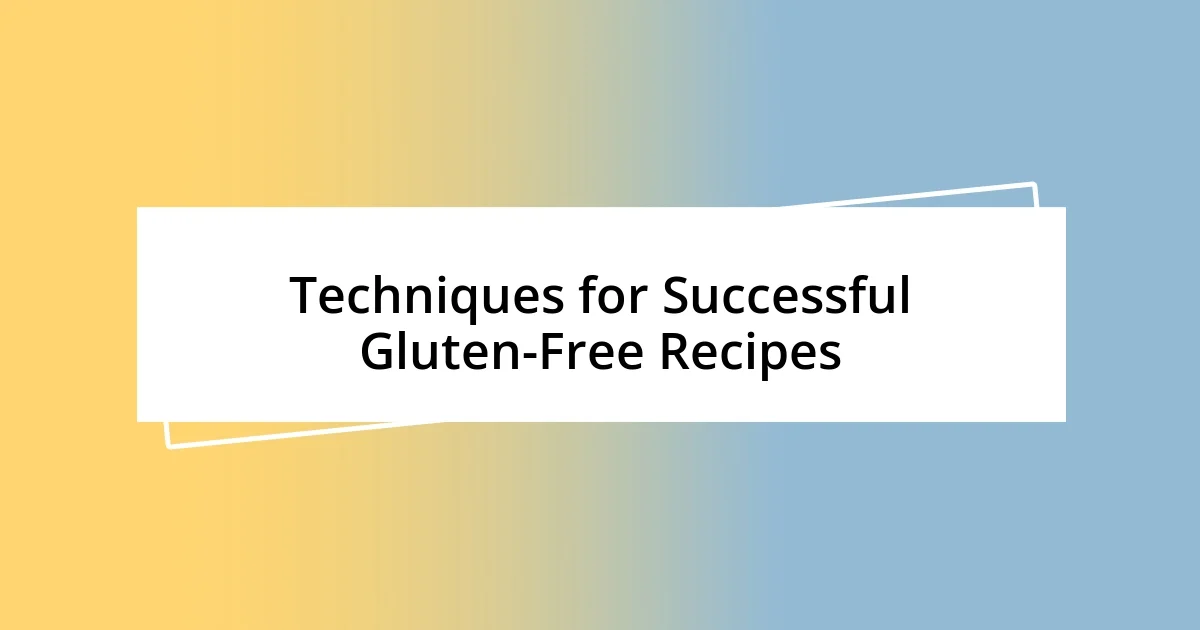Key takeaways:
- Choosing the right gluten-free flour blends is crucial for achieving desired flavors and textures in baking.
- Understanding gluten’s impact highlights the importance of gluten-free baking for those with intolerance or celiac disease.
- Common mistakes include over-reliance on single flours, miscalculating binders, and skipping resting times for dough.

Getting Started with Gluten-Free Baking
When I first stepped into gluten-free baking, I remember feeling a mixture of excitement and intimidation. It was like standing at the base of a mountain, unsure if I could make it to the top. The key for me was to treat it as an adventure; every failed batch became a lesson rather than a setback. Have you ever felt that way, diving into a new culinary challenge?
One of the most important aspects I discovered is the significance of choosing the right gluten-free flour. I’ll never forget the first time I used almond flour – it transformed my muffins into a moist, flavorful treat. It taught me that experimenting with different blends can unlock flavors you never thought possible. What flours have you been curious about but haven’t tried yet?
As I ventured deeper into this world, I found that community support was invaluable. Connecting with fellow gluten-free bakers online and sharing successes—and yes, even the occasional flop—added a layer of fun and camaraderie. I often ask myself how I ever managed without that shared experience. Have you reached out to others in your baking journey? It can make a world of difference!

Understanding Gluten and Its Impacts
Understanding gluten is essential in navigating the world of gluten-free baking. I recall my first encounter with gluten; it was the elastic quality of dough that fascinated me. Watching gluten form during kneading was like witnessing a magic trick. It’s that stretchy texture that gives traditional bread its beloved chewiness, but for those with gluten intolerance or celiac disease, gluten can wreak havoc on the digestive system, leading to discomfort and health issues. Have you ever considered how something as simple as bread could have such profound effects on our bodies?
As I delved deeper, I learned that gluten isn’t just a single component; it’s a complex mixture of proteins found in wheat and related grains. When I discovered that even the smallest amounts of gluten could cause reactions in sensitive individuals, it truly hit home. There was a time when I accidentally consumed gluten and spent the next few days feeling lethargic and bloated. That experience ignited my commitment to gluten-free baking, knowing that for many, this isn’t merely a dietary choice—it’s a necessity for health.
In my quest for understanding gluten’s impact, I found it fascinating how dietary changes have transformed many lives. I remember a friend who, upon eliminating gluten, experienced a surge in energy and clarity that she never thought possible. This kind of transformation is not unusual. Have you seen positive changes in those who have gone gluten-free? It’s a reminder that our bodies react uniquely to what we consume, which is why being informed is so vital.
| Aspect | Traditional Gluten | Gluten-Free Alternatives |
|---|---|---|
| Texture | Chewy and elastic | Varies significantly, often crumbly |
| Health Impact | Safe for most | Essential for gluten intolerance/celiac |
| Source | Wheat and related grains | Almond, coconut, rice flours, etc. |

Essential Ingredients for Gluten-Free Baking
When I took my first plunge into gluten-free baking, I quickly realized that not all flours are created equal. I remember the confusion of staring at a shelf full of options—rice flour, oat flour, and the mysterious tapioca flour, to name a few. Choosing the right flour blend turned out to be crucial for achieving the flavors and textures I desired. For me, combining different flours became a bit like crafting a perfect recipe—every choice influences the outcome. It’s a delightful puzzle that keeps my baking adventures exciting.
Here’s a quick rundown of essential ingredients I’ve found invaluable in gluten-free baking:
- Almond Flour: Adds moisture and a delightful nutty flavor.
- Coconut Flour: Highly absorbent; great for adding fiber but needs extra liquid or binding agents.
- Tapioca Flour: Helps create a chewy texture and gives baked goods a crispy crust.
- Brown Rice Flour: A great base flour that works well in blends.
- Xanthan Gum or Psyllium Husk: These act as binders to mimic the elasticity of gluten.
- Baking Soda and Baking Powder: Essential for leavening, ensuring that your baked goods rise beautifully.
Thinking back, my first batch using a blend of brown rice and almond flour was a game changer. It was a simple cookie, but the texture was surprisingly spot-on, and I felt an electrifying rush of joy knowing I was onto something special. It’s moments like these that fuel my passion for gluten-free baking, turning even the simplest ingredients into the start of something delicious. Have you found any flavor combinations that surprised you?

Techniques for Successful Gluten-Free Recipes
Baking techniques for gluten-free recipes require some adjustments, and I learned early on that patience is key. During my first attempts, I frequently overmixed the batter, leading to dense and dry results. It wasn’t until I embraced the idea of gently folding ingredients that I started to see a real difference in texture. Have you ever felt that surge of triumph when a baked good turns out light and airy?
Another crucial technique I’ve adopted is the importance of letting the dough rest. Gluten-free flours often benefit from hydration, which means allowing what you’ve mixed to sit for a while. I remember a batch of brownies that sat for an hour before baking, and when I finally took them out of the oven, they were rich and fudgy—exactly what I wanted. It’s astonishing how a bit of time can transform your final product!
I also find that experimenting with different baking times and temperatures can yield surprising results. Just last week, I decided to bake a loaf at a lower temperature for a longer period. The outcome was a beautifully caramelized crust that I hadn’t achieved before. Have you ever tweaked a recipe and stumbled upon a hidden gem? These little adjustments truly make gluten-free baking an adventure!

Common Mistakes in Gluten-Free Baking
One of the most common mistakes I’ve encountered in gluten-free baking is over-reliance on a single type of flour. Early on, I thought almond flour could do it all, but my cookies came out too crumbly. It took some experimentation with different blends to discover the right balance. Have you ever noticed how mixing flours can transform a baked good from mediocre to magical?
Another pitfall I stumbled upon was misjudging the amount of xanthan gum or psyllium husk needed. I’ll never forget the first time I made a cake that was as dense as a brick—talk about a major disappointment! It was a learning moment; just the right amount of these binders can create that lovely elasticity we often miss when going gluten-free. Have you grappled with finding the sweet spot in your recipes too?
One mistake that might not be obvious is skipping the resting time for the dough. I remember the first time I rushed a batch of pizza dough, only to pull out a rubbery, flat disappointment. Letting the dough rest allows the flours to fully hydrate and improve texture, a simple step that makes a world of difference. Have you experienced this too? Trust me, a little patience pays off!

Tips for Perfect Gluten-Free Desserts
When it comes to gluten-free desserts, choosing the right sweetener can significantly affect the flavor and texture. I remember the first time I swapped out regular sugar for coconut sugar—what a revelation! The depth of flavor it added was a delightful surprise, transforming my cookies into a chewy, flavorful treat. Have you experimented with alternative sweeteners yet? You might just find a new favorite.
Another essential tip is to add moisture-rich ingredients like applesauce or yogurt to your batter. During my initial baking adventures, I often forgot about this crucial step, resulting in overly dry cakes. Once I incorporated applesauce into my carrot cake, the result was a luscious, moist slice that practically melted in my mouth. Isn’t it amazing how something so simple can elevate your baked goods?
Finally, I’ve learned that chilling cookie dough before baking can enhance the flavors and improve the texture. Once, I hurriedly baked a batch of cookies without chilling, and they spread out into flat puddles. But when I took the time to let the dough rest in the fridge, the cookies came out perfectly thick and chewy. Isn’t it fascinating how a brief pause can yield such delicious results?














